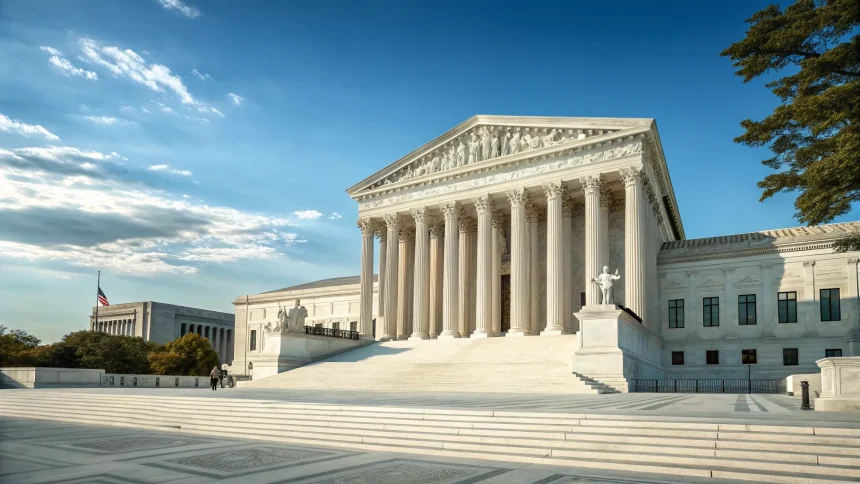The U.S. Supreme Court may soon decide the fate of a key tariff tool used during the Trump administration, a ruling that could alter how presidents impose trade barriers. The case could make some existing tariffs irrelevant, yet the debate is not about ending tariffs altogether. It is about which legal paths remain open and how a future White House might use them.
The discussion comes as businesses, workers, and consumers wait for clarity on trade policy that has shaped prices, supply chains, and negotiations with major trading partners since 2018. While the exact timing of a decision is uncertain, the stakes are high for manufacturers and importers planning next year’s orders and investment.
Background: How Tariffs Became a Central Tool
Tariffs reemerged as a central policy instrument during the Trump administration, which imposed duties on hundreds of billions of dollars in imports. Those actions sparked retaliation from trading partners and reshaped supply chains. Some of the levies have continued under the Biden administration, reflecting bipartisan concern over trade imbalances and national security risks in key sectors.
Presidents have several legal options to set tariffs without new legislation. These include authorities tied to national security, unfair trade practices, and temporary safeguards. The Supreme Court’s forthcoming decision could narrow one of those channels, but others remain in play.
What The Show Highlighted
“The U.S. Supreme Court may soon rule on President Trump’s favorite tariff law. It could render them moot, but that doesn’t mean the end of tariffs.”
The program framed a simple question with wide-reaching consequences: if one legal basis for tariffs falls, what comes next? It also pointed listeners to earlier reporting on legality and effectiveness, suggesting that the court’s move would redirect, not stop, tariff policy.
If One Door Closes, Others Stay Open
Even if the court limits a favored statute, future presidents retain other tariff routes that can affect the same industries and products, though the timelines and legal thresholds differ. Among the options often used or discussed in recent decades:
- National security tariffs under long-standing trade law tied to defense and critical industries.
- Tariffs addressing unfair trade or intellectual property concerns, often focused on specific countries or sectors.
- Temporary “safeguard” measures to help industries adjust to import surges, usually time-limited and subject to review.
- Enforcement of anti-dumping and countervailing duties through investigations that target specific products and producers.
Each path carries trade-offs. Some offer speed and wide scope but face legal scrutiny. Others require detailed investigations and invite formal input from businesses and workers. A court ruling might push the executive branch toward more targeted, evidence-heavy cases that take longer to implement but may be harder to overturn.
Industry, Consumer, and Global Effects
Tariffs raise costs for importers, which can translate into higher prices for consumers. Some manufacturers benefit from protection, while others face higher input costs. Retailers and logistics firms adjust orders and sourcing to minimize duties, sometimes shifting production to third countries or reworking supply chains.
Trading partners may respond with their own tariffs, pressuring U.S. exporters in agriculture, machinery, and services. A court ruling that narrows one tariff path could ease tensions if it leads to fewer unilateral measures. But if a president pivots to other authorities, trade friction could continue in different forms.
Legal Clarity vs. Policy Flexibility
Businesses often prefer predictable rules. A clear ruling could reduce uncertainty about sudden tariff changes under one statute. Yet the persistence of alternative tools means companies will still need to plan for shifting duties and ongoing trade disputes.
Analysts expect any change to influence bargaining with major partners. If one authority is curtailed, future administrations might lean more on targeted cases or negotiate settlements tied to specific sectors, such as semiconductors, solar equipment, or critical minerals.
What To Watch Next
Companies are watching for clues in supply chain data and the timing of procurement. Any Supreme Court decision will likely trigger agency guidance and potential new investigations under other laws. Lawmakers could also weigh in with legislation if they see a need to clarify presidential powers or strengthen oversight.
“That doesn’t mean the end of tariffs.”
That line reflects a key takeaway: the tools may change, but the policy objective—shaping trade flows and negotiating leverage—remains. The battleground could shift from broad, fast-moving measures to narrower, case-driven actions that still carry real costs and benefits.
For now, importers and exporters should prepare for a period of transition. The court’s decision may reset one playbook, but the next chapter in U.S. tariff policy is likely to be written through a blend of legal channels, agency actions, and international negotiations.







